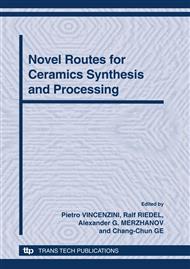p.246
p.251
p.257
p.263
p.273
p.282
p.287
p.297
p.302
Self-Propagating High-Temperature Synthesis of Iron- and Copper-Matrix Cermets
Abstract:
The presentation will report on the adoption of two different approaches based on selfpropagating high-temperature synthesis (SHS) to produce cermets. The first of these concerns the formation of the solid solution carbide, (Ti,V)C, of various compositions in an iron matrix by starting with elemental powders. It was observed that two types of carbide particles were generated within the matrix; a (Ti,V)C carbide of submicron size and a TiC-rich carbide of slightly higher size. Comparison of SHS Fe-TiC products showed that the addition of vanadium led to refinement of the carbide dispersions. The mechanism of formation of Fe-(Ti,V)C cermets will be discussed using chemical thermodynamic analysis. The second SHS approach involves the reaction between titanium and graphite by dropping compacted powders into a copper melts at 1250°C. The process yielded dispersions of TiC within the matrix as well as graphite flakes. The reaction mechanism will be discussed and the potential of SHS to yield dispersions within metal matrices will be assessed.
Info:
Periodical:
Pages:
273-281
Citation:
Online since:
October 2010
Authors:
Price:
Сopyright:
© 2010 Trans Tech Publications Ltd. All Rights Reserved
Share:
Citation:


